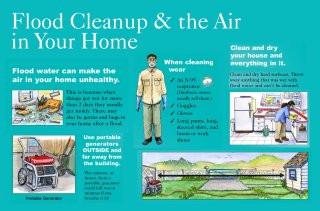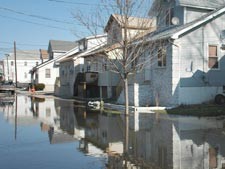Flooding
ALWAYS CALL 911 if you are in immediate danger and need emergency help.
Prepare for flooding
For communities, companies, or water and wastewater facilities:
- Flood Resilience Guide is your one-stop resource to protect your critical assets. Targeted to small and medium drinking water and wastewater utilities.
- General activities to help facilities plan for emergencies and natural disasters. A variety of tools and guidance for drinking water and wastewater utilities to prepare and respond.
- Improve the security and resilience of drinking water and wastewater infrastructure.
- VIDEO: Surviving the Quake. This video introduces you to earthquake resilience and highlights Earthquake Resilience for Water and Wastewater Utilities.
- VIDEO: Surviving the Quake. This video introduces you to earthquake resilience and highlights Earthquake Resilience for Water and Wastewater Utilities.
During flooding
State and local response agencies are the primary responders for people who are concerned about or were affected by flooding. Find your state emergency office or agency from FEMA.
Avoid contact with flood water due to potentially elevated levels of contamination associated with raw sewage and other hazardous or toxic substances that may be in the flood water. EPA and the Department of Health and Human Services urge everyone in contact with flood waters to follow these guidelines:
- Avoid or limit direct contact with contaminated flood water.
- Wash your hands frequently with soap, especially before drinking and eating.
- Do not allow children to play in flood water, or play with toys contaminated with flood water.
- Report cuts or open wounds, and report all symptoms of illness. Keep vaccinations current.
- More about health risks from flood waters.
Recover after flooding

ALERT: Generator exhaust is toxic. Always put generators outside well away from doors, windows, and vents. Never use a generator inside homes, garages, crawlspaces, sheds, or similar areas. Carbon monoxide (CO) is deadly, can build up quickly, and linger for hours. More information.
- Never heat your home using a "combustion appliance" such as a gas stove, oven, barbeque grill, or dryer. Never operate any gas-burning heater or other appliance in a poorly vented or closed room, or where anyone is sleeping.
- Listen: Public Service Announcement about carbon monoxide (also en español)
- en español: Proteja su vida y la de su familia: Evite el envenenamiento con monóxido de carbono (español) - conozca los síntomas del envenenamiento con monóxido de carbono.
Limit contact with flood water.
Flood water may have high levels of raw sewage or other hazardous substances. Early symptoms from exposure to contaminated flood water may include upset stomach, intestinal problems, headache and other flu-like discomfort. Anyone experiencing these and any other problems should immediately seek medical attention.
- EPA's Sanitary Survey App for Marine and Fresh Waters online tool helps communities protect swimmers and other recreators while improving management decisions regarding pollution and recreational waters.
What do I do with my home septic system after a flood? Do not use the sewage system until water in the soil absorption field is lower than the water level around the house. If you have a home-based or small business and your septic system has received chemicals, take extra precautions to prevent contact with water or inhaling fumes. Proper clean-up depends on the kinds of chemicals in the wastewater. Read more
- About reentering a flooded home, from CDC.
Children: Protect children after a flood. Be sure children are protected from chemicals and diseases in flood water. Behavior such as crawling or placing objects in their mouths can increase a child's risk of exposure and sickness.
Drinking water and food
Please check with your local drinking water utility or health department about water safety in your area, and to confirm whether you are under a boil water advisory.
- Boiling water information– To kill all major water-borne bacterial pathogens, bring water to a rolling boil for 1 full minute. Boil 3 minutes at elevations above 5280 ft (1 mile or 1.6 km). Getting and disinfecting water.
- What do I do about water from household wells after a flood? Do not turn on the pump due to danger of electric shock. Do not drink or wash with water from the flooded well until it is tested and safe to use. Read more.
Mold
- Mold cleanup: Mold can cause serious health problems. The key to mold control is moisture control. After the flood, remove standing water and dry indoor areas. Remove and discard anything that has been wet for more than 24-48 hours.
- Mold cleanup in schools and commercial buildings. Information for building managers, custodians, and others who are responsible for commercial building and school maintenance.
- Basic mold hazards. Cleaning up mold. What to wear
- More about mold from Centers for Disease Control
Managing debris
Disasters can generate tons of debris, including building rubble, soil and sediments, green waste (e.g.., trees and shrubs), personal property, ash, and charred wood. How a community manages disaster debris depends on the debris generated and the waste management options available. Burying or burning is no longer acceptable, except when permission or a waiver has been granted, because of the side effects of smoke and fire from burning, and potential water and soil contamination from burial. Typical methods of recycling and solid waste disposal in sanitary landfills often cannot be applied to disaster debris because of the large volume of waste and reluctance to overburden existing disposal capacity.
- Managing Debris After a Natural Disaster - a fact sheet with guidelines to help make for a speedier removal process.
- General information on disaster debris - planning for and management of debris is an essential but often overlooked component of an emergency response or disaster incident.
Eliminate standing water where mosquitos can breed
Mosquitos can sharply increase after a flood, due to the sudden availability of standing water which they require for breeding -- even very small amounts of water. As flood waters recede be sure to drain, overturn, or empty areas -- no matter how small -- to reduce mosquito breeding areas and help reduce the spread of mosquito-borne diseases.
- Get rid of standing water in rain gutters, old tires, buckets, plastic covers, toys, pools, or any other containers.
- Empty water from damaged materials that aren't usually outdoors, such as discarded furniture, household items, bookshelves, building materials, trash, etc.
- Drain wet areas and puddles of water, or fill them with dirt.
- More ideas for controlling mosquitos
- Why? The importance of controlling mosquito-borne diseases, such as West Nile Virus or Zika
For water and wastewater facilities:
For water and wastewater facilities: Suggested post-hurricane activities to help facilities recover.
Renovation and rebuilding
Lead-safe work: By law, contractors need to use lead-safe work practices on emergency renovations on homes or buildings built before 1978. Activities such as sanding, cutting, and demolition can create lead-based paint hazards. Lead-contaminated dust is harmful to adults, particularly pregnant women, and children.
- Important information about post-disaster renovations and lead-based paint
- Ways to protect against lead-based paint hazards
Asbestos: Anyone working on demolition, removal, and cleanup of building debris needs be aware of any asbestos and to handle asbestos materials properly. People exposed to asbestos dust can develop serious lung health problems including asbestosis, lung cancer and mesothelioma. Although the use of asbestos has dramatically decreased in recent years, it is still found in many residential and commercial buildings and can pose a serious health risk.
Underground Storage Tanks
During a flood, underground storage tank (UST) systems may become displaced or damaged and release their contents into the environment, causing soil, surface water, and groundwater contamination.
- Learn more what UST owners or operators can do to minimize risks from damaged USTs on human health and the environment during flooding.

